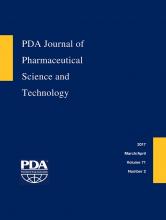Abstract
The assurance of sterility of a parenteral drug product, prior to any human use, is a regulatory requirement. Hence, all strategies related to container closure integrity (CCI) must demonstrate absence of microbial contamination through leaks as part of the container closure system (CCS) qualification, during manufacturing, for quality control purposes and to ensure microbiological integrity (sterility) during storage and shipment up to the end of product shelf life. Current regulatory guidances, which differ between countries and regions, provide limited detail on how to assess CCI. The new revision of USP <1207> aims to provide extensive and detailed guidance for CCI assessments for sterile products. However, practical questions and considerations are yet to be addressed by the pharmaceutical industry. These may include: (1) choice of method, for example whether a deterministic CCI method (e.g., helium leak) is preferable over the probabilistic CCI method (e.g., microbial ingress), (2) the type of primary packaging (e.g., vial, syringe, device), (3) dosage form (e.g., liquid versus lyophilisate), (4) suitable acceptance criteria, (5) appropriate sample size, (6) the most appropriate way to introduce artificial leaks into the CCS, (7) ensuring suitable assurance of CCI during drug product manufacturing, and (8) evaluating CCI under intended shipment and storage conditions (e.g., in the frozen state).
A group of European industry peers have met to discuss these and other related questions in order to provide their viewpoint and best practice on practical approaches to CCI. Their perspective is provided in this white paper. Through these discussions, it became clear that there is currently no gold standard for CCI test methods or for the generation of artificial leaks; therefore flexibility toward CCI approaches is required. Although there should be flexibility, any CCI approach must consider the intended use (e.g., CCS qualification, routine manufacturing, or quality control) and product design (e.g., primary packaging, liquid versus dried product).
LAY ABSTRACT: The assurance of sterility of a parenteral drug product prior to any human use is a regulatory requirement. Hence, all strategies related to container closure integrity (CCI) must demonstrate absence of microbial contamination through leaks as part of the container closure system (CCS) qualification, during manufacturing, for quality control purposes and to ensure microbiological integrity (sterility) during storage and shipment up to the end of shelf life. Current regulatory guidances, which differ between countries and regions, provide limited detail on how to assess CCI. The new revision of USP <1207> aims to provide extensive and detailed guidance for CCI assessments for sterile products. However, practical questions and considerations are yet to be addressed by the pharmaceutical industry.
A group of European industry peers have met to discuss these and other related questions in order to provide their viewpoint and best practice on practical approaches to CCI. Their perspective is provided in this white paper. Through these discussions, it became clear that there is currently no gold standard for CCI test methods or for the generation of artificial leaks; therefore flexibility toward CCI approaches is required. Although there should be flexibility, any CCI approach must consider the intended use (e.g., CCS qualification, routine manufacturing, or quality control) and product design (e.g., primary packaging, liquid versus dried product).
- Container closure integrity testing
- Methods for container closure integrity testing
- Artificial leaks
- Industry perspective
- Container closure system
- Primary packaging
- USP <1207>
- © PDA, Inc. 2017
PDA members receive access to all articles published in the current year and previous volume year. Institutional subscribers received access to all content. Log in below to receive access to this article if you are either of these.
If you are neither or you are a PDA member trying to access an article outside of your membership license, then you must purchase access to this article (below). If you do not have a username or password for JPST, you will be required to create an account prior to purchasing.
Full issue PDFs are for PDA members only.
Note to pda.org users
The PDA and PDA bookstore websites (www.pda.org and www.pda.org/bookstore) are separate websites from the PDA JPST website. When you first join PDA, your initial UserID and Password are sent to HighWirePress to create your PDA JPST account. Subsequent UserrID and Password changes required at the PDA websites will not pass on to PDA JPST and vice versa. If you forget your PDA JPST UserID and/or Password, you can request help to retrieve UserID and reset Password below.






